七上unit 5--unit 9 单元语法课件(共39张PPT)
文档属性
| 名称 | 七上unit 5--unit 9 单元语法课件(共39张PPT) | 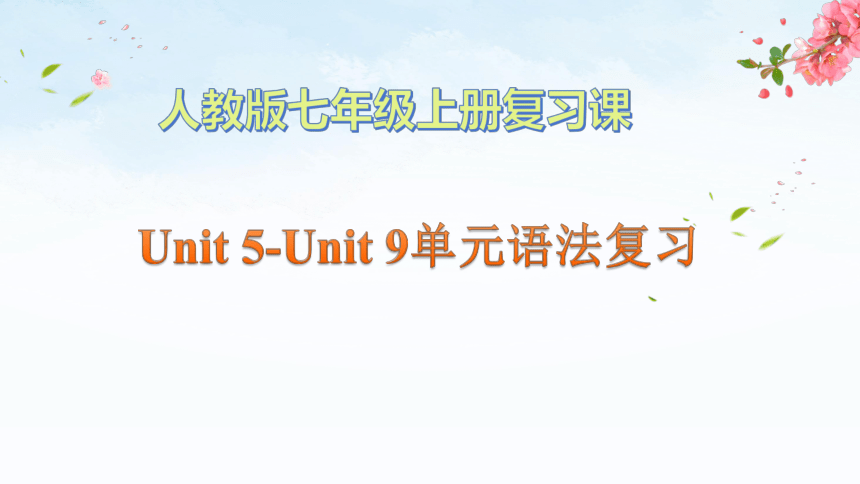 | |
| 格式 | pptx | ||
| 文件大小 | 3.2MB | ||
| 资源类型 | 教案 | ||
| 版本资源 | 人教新目标(Go for it)版 | ||
| 科目 | 英语 | ||
| 更新时间 | 2024-01-04 14:06:43 | ||
图片预览

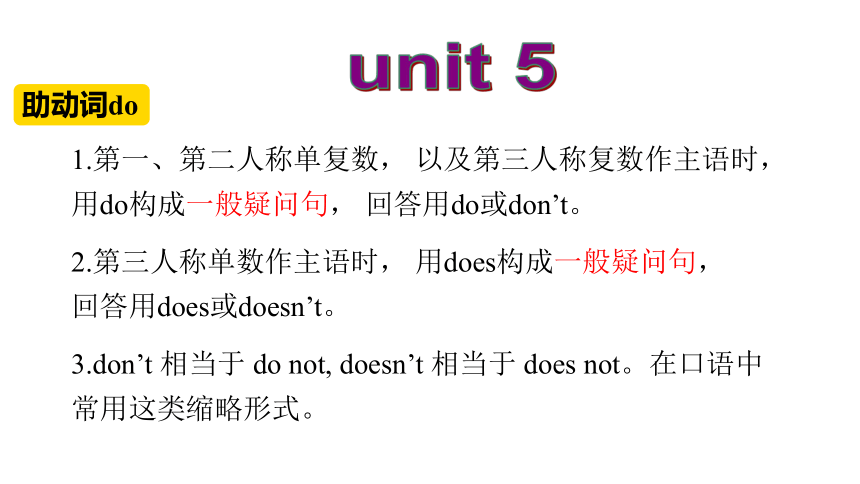
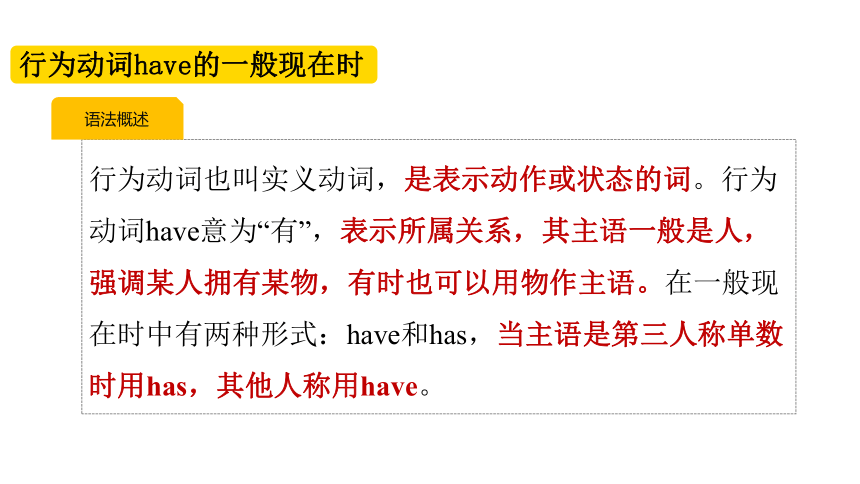
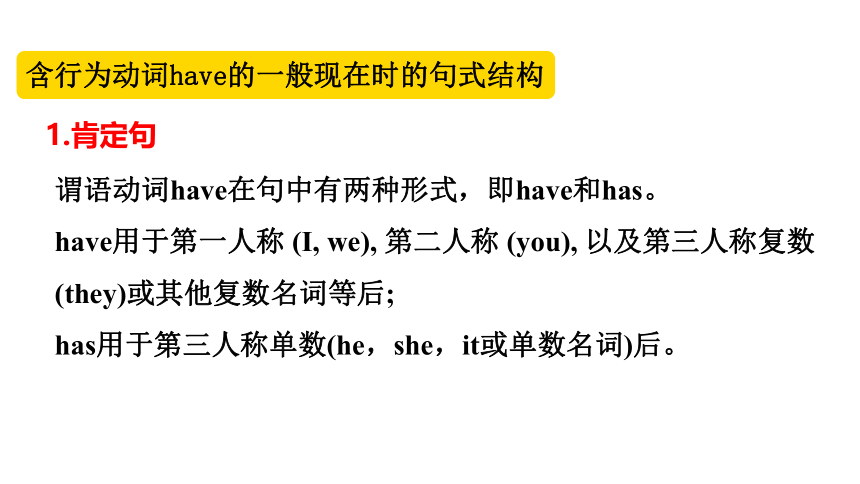

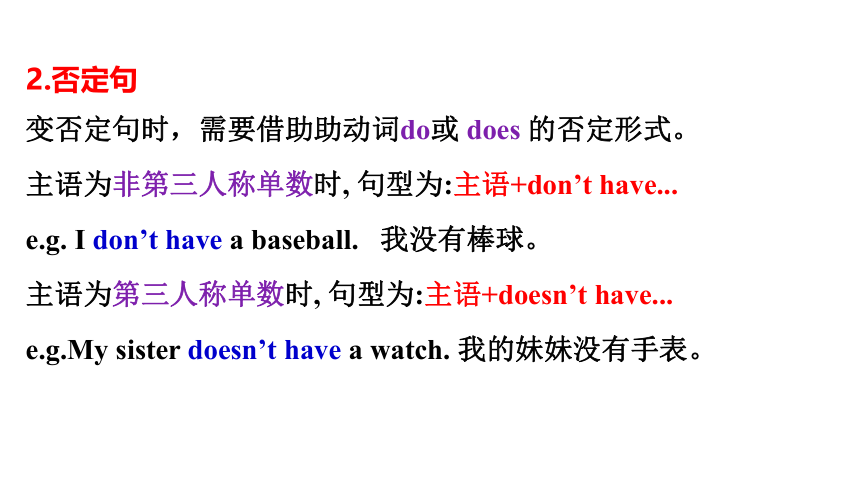
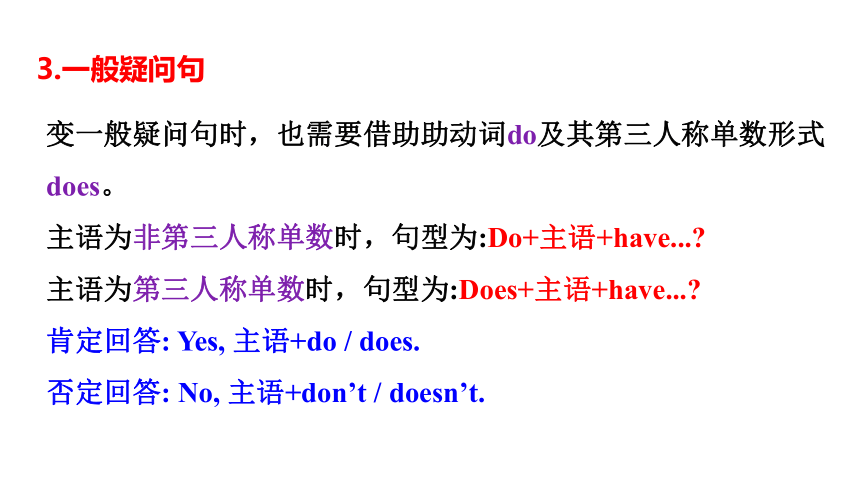
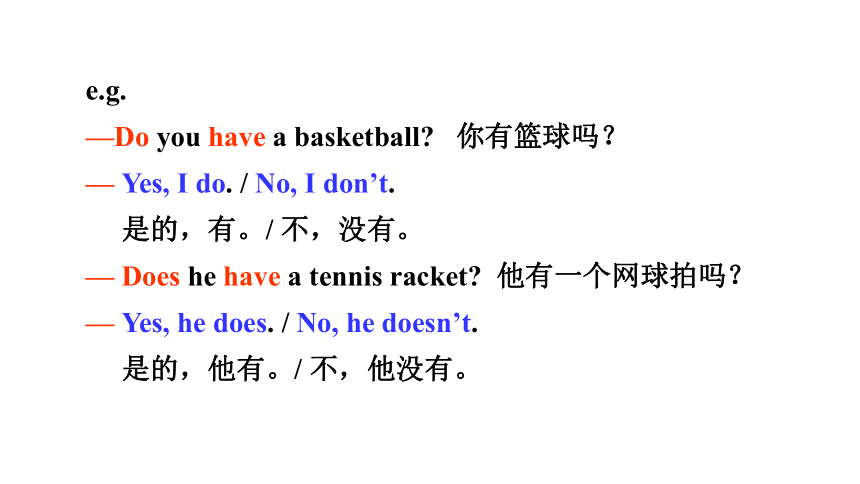
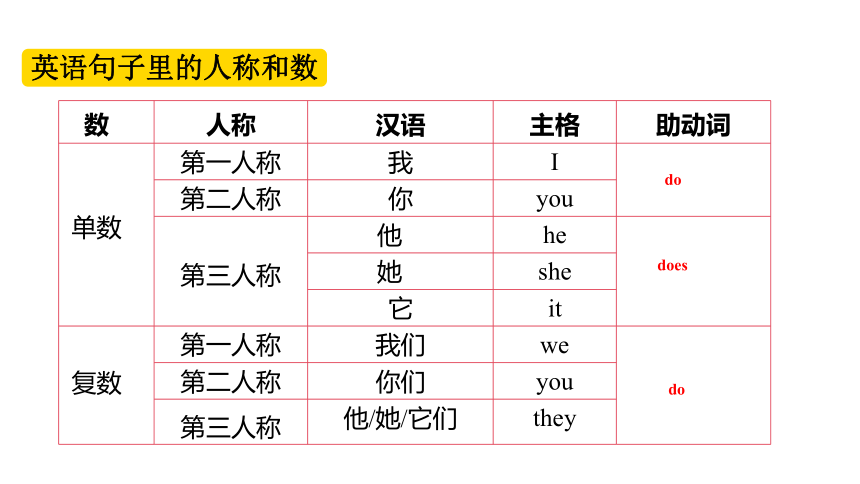
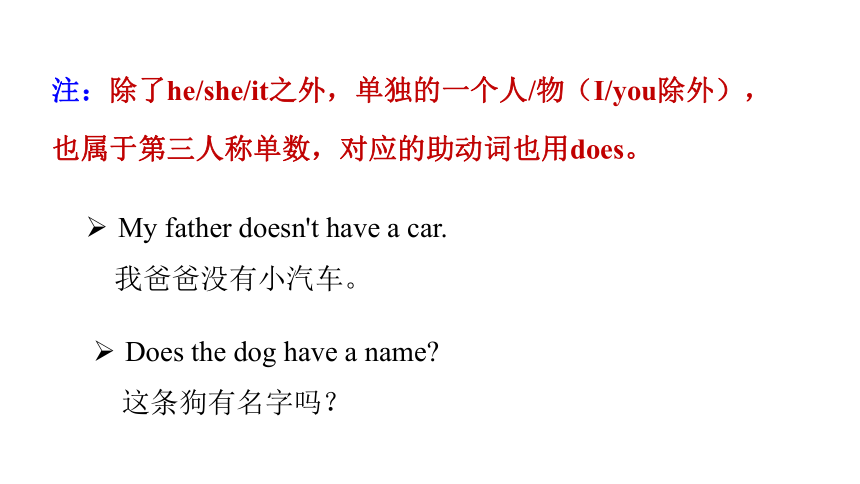

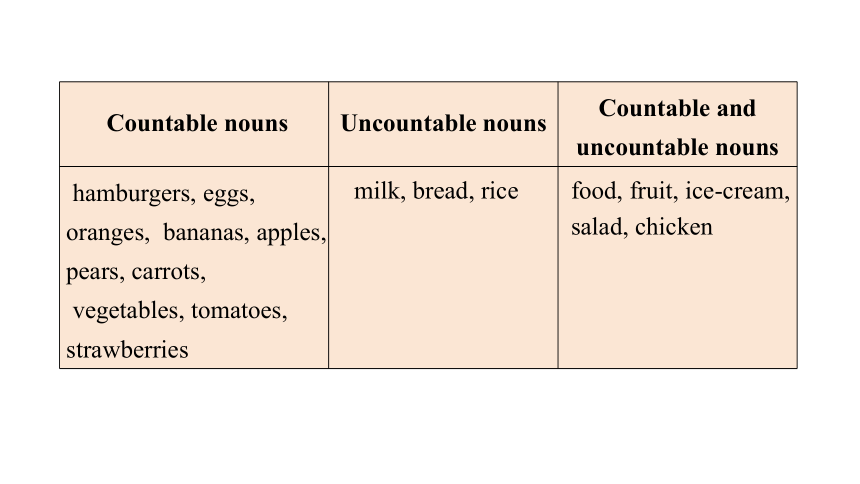
文档简介
(共39张PPT)
人教版七年级上册复习课
Unit 5-Unit 9单元语法复习
unit 5
助动词do
1.第一、第二人称单复数, 以及第三人称复数作主语时, 用do构成一般疑问句, 回答用do或don’t。
2.第三人称单数作主语时, 用does构成一般疑问句, 回答用does或doesn’t。
3.don’t 相当于 do not, doesn’t 相当于 does not。在口语中常用这类缩略形式。
行为动词也叫实义动词,是表示动作或状态的词。行为动词have意为“有”,表示所属关系,其主语一般是人,强调某人拥有某物,有时也可以用物作主语。在一般现在时中有两种形式:have和has,当主语是第三人称单数时用has,其他人称用have。
行为动词have的一般现在时
语法概述
含行为动词have的一般现在时的句式结构
谓语动词have在句中有两种形式,即have和has。
have用于第一人称 (I, we), 第二人称 (you), 以及第三人称复数 (they)或其他复数名词等后;
has用于第三人称单数(he,she,it或单数名词)后。
1.肯定句
e.g.
I have a baseball. 我有一个棒球。
They have some good friends. 他们有一些好朋友。
Tom has a Chinese friend. 汤姆有一位中国朋友。
The school has three grades. 这所学校有三个年级。
变否定句时,需要借助助动词do或 does 的否定形式。
主语为非第三人称单数时, 句型为:主语+don’t have...
e.g. I don’t have a baseball. 我没有棒球。
主语为第三人称单数时, 句型为:主语+doesn’t have...
e.g.My sister doesn’t have a watch. 我的妹妹没有手表。
2.否定句
变一般疑问句时,也需要借助助动词do及其第三人称单数形式does。
主语为非第三人称单数时,句型为:Do+主语+have...
主语为第三人称单数时,句型为:Does+主语+have...
肯定回答: Yes, 主语+do / does.
否定回答: No, 主语+don’t / doesn’t.
3.一般疑问句
e.g.
—Do you have a basketball 你有篮球吗?
— Yes, I do. / No, I don’t.
是的,有。/ 不,没有。
— Does he have a tennis racket 他有一个网球拍吗?
— Yes, he does. / No, he doesn’t.
是的,他有。/ 不,他没有。
数 人称 汉语 主格 助动词
单数 第一人称 我 I
第二人称 你 you 第三人称 他 he
她 she 它 it 复数 第一人称 我们 we
第二人称 你们 you 第三人称 他/她/它们 they do
does
do
英语句子里的人称和数
注:除了he/she/it之外,单独的一个人/物(I/you除外),也属于第三人称单数,对应的助动词也用does。
My father doesn't have a car.
我爸爸没有小汽车。
Does the dog have a name
这条狗有名字吗?
unit 6
动词like的一般现在时用法
肯定句 主语+like(s)+其他 I like oranges. 我喜欢橙子。
She likes pears. 她喜欢梨。
否定句 主语+ don’t/ doesn’t like +其他 I don’t like oranges. 我不喜欢橙子。
She doesn’t like pears. 她不喜欢梨。
一般疑问句及其回答 Do(es)+主语+like+其他? 肯定回答: Yes,主语+do(es). 否定回答: No, 主语+don’t/ doesn’t. —Do you like oranges 你喜欢橙子吗?
—Yes, I do./ No, I don’t.
是的, 我喜欢。/不, 我不喜欢。
—Does she like pears 她喜欢梨吗?
—Yes, she does./ No, she doesn’t.
是的,她喜欢。/ 不, 她不喜欢
Countable nouns Uncountable nouns Countable and uncountable nouns
hamburgers, eggs, oranges, bananas, apples, pears, carrots, vegetables, tomatoes, strawberries milk, bread, rice food, fruit, ice-cream,
salad, chicken
可数名词与不可数名词
名词是指人或事物的名称。根据所表示事物的性质,名词可分为可数名词和不可数名词。可数名词有复数形式,不可数名词一般没有复数形式。
语法概述
可数名词
(1)
(2)
(3)
(4)
定义:是可以计数的名词。
可数名词前可以用 a , an 限定,表一个。
可数名词前可以用 one, two, three …等数词限定。
可数名词有复数形式。
可数名词的复数形式构成
名词特点 词尾加法 词尾读音方法 例词
一般情况下
加-s
1. -s在清辅音后读[s]
2. -s在浊辅音后读[z]
3. -s在元音后读[z]
4. 以音素[ s , z , ,d ] ]等结尾的,读[iz]
desks
dogs
trees
oranges
以-s, -x, -sh, -ch 结尾的
加-es
-es读[iz]
boxes
watches
以 f 或 fe 结尾的
改f或fe为v 再加-es
-ves读[vz]
knives
wives
名词特点 词尾加法 词尾读音方法 例词
改y为i 再加-es
-ies读[iz]
families
dictionaries
以元音字母
加y结尾的
加-s
-s读[z]
boys
keys
以o 结尾的
有生命的事物加-es
-es读[z]
tomatoes
potatoes
以辅音字母加y结尾的
无生命的事物加-s
-s读[z]
photos
radios
可数名词复数形式的不规则变化
类别 单数 复数
单复数同形 deer(鹿) deer
Chinese(中国人) Chinese
sheep(绵羊) sheep
单复数不同形 词尾发生变化 child(小孩) children
改变单词的元音字母 woman(妇女) women
man(男人) men
tooth(牙齿) teeth
foot(脚) feet
不可数名词
(1)
(2)
(3)
(4)
定义:是指表示不能计数的事物的名词。
不可数名词前不可以用 a , an 限定。
不可数名词前不可以用 one, two , three… 限定。
不可数名词没有复数形式。
常见的不可数名词
粉末/颗粒类,如:flour(面粉),rice(米饭)
液体、气体等,如:water(水),air(空气)
语言、学科等,如:English(英语),Chinese(汉语)
肉类,如:beef(牛肉),pork(猪肉)
油脂类,如:oil(油),butter(黄油)
一些抽象名词,如:knowledge(知识),friendship(友谊)
既可数又不可数名词
可数名词词义 不可数名词词义
chicken 鸡 鸡肉
glass 玻璃杯 玻璃
room 房间 空间
time 次; 回 时间
orange 橙子 橙汁
有些名词既可作可数名词,又可作不可数名词, 但词义不同。
how much引导的特殊疑问句(询问价格)
“How much + is/are +名词?”用于询问价格,意为“……多少钱?”,其答语为“It’s/They’re+价格.”, 也可直接用价格回答。
how much询问价格时,“How much is/are… ”相当于“What’s the price of… ”。
How much are those apples =What’s the price of those apples
那些苹果多少钱?
unit 7
Exercises
1. How much is this red skirt
——————————————
2. How much are those yellow socks
____________________________
3. How much is that brown T-shirt
____________________________
一、英译汉。
这件红色的短裙多少钱?
那些黄色的袜子多少钱?
那件棕色的T恤衫多少钱?
1. The chicken is 25 yuan.(对画线部分提问)
_______ ________ _______ the chicken
2. The shorts are $40.(对画线部分提问)
_______ ________ _______ the shorts
3. How much is this pen (改为复数句)
How much _______ ________ _______
二、句型转换。
How much
are
is
How much
are
these
pens
三、单项选择。
1. — What can I do for you
— ______________.
A. Yes, you can give a skirt to me B. I want a skirt
C. No, I can do it myself D. I can do what I want
2. — How much ______ the skirt
— ______ thirty yuan.
A. is; It’s B. are; They’re
C. is; They’re D. are; It’s
B
A
3. The yellow shorts ______ 15 yuan.
A. is on sale B. are on sale
C. are on sell for D. are on sale for
4. This hat is _____.
A. 10 yuan’s B. 10 dollar
C. 10 dollars D. dollar 10
5. I think your trousers _____ very nice.
A. be B. is C. am D. are
C
D
D
unit 8
When is your birthday My birthday is on May 2nd.
When is his birthday His birthday is on January 17th.
When is her birthday It's in August.
When is Alice's birthday Her birthday is on September 5th.
When is your father's birthday His birthday is on April 21st.
询问他人生日日期:When is birthday
“名词+’s ” 所有格
形容词性物主代词
“名词+'s”所有格
1) 单数名词后加“ 's ”(以-s结尾的人名后加“ ' ”或“ 's ”)。
my sister's book 我姐姐的书
2) 以-s结尾的复数名词只加“ ' ”,不以-s结尾的复数名词通常加“ 's ”。
the three girls’ father 这三个女孩的父亲
the three children’s father 这三个孩子的父亲
“名词+'s”所有格主要用于有生命的名词的所有关系。
3) 表示几个人共有,仅在最后一个人的名字后加“’s”;表示各自所有时,应在各个名字后加“’s”。
Mary and Jane’s car 玛丽和简的汽车
Mary’s and Jane’s cars 玛丽和简的汽车
(她们共有的汽车)
(她们各自的汽车)
of 所有格
1) of 所有格多用于表示无生命事物的名词的所有关系。
a map of China 一幅中国地图
2) of 所有格也可用于表示人和其他有生命的名词的所有关系。
the name of her cat 她的猫的名字
the girl’s new dress = the new dress of the girl 这个女孩的新连衣裙
3) ’s所有格和of 所有格有时可以互相转换。
序数词
表示人或事物先后顺序的数词叫序数词。序数词大多数是由基数词变化而来的,序数词往往与定冠词the连用。
语法概述
序数词的构成
1) 1-3的序数词first / second / third与基数词差别很大,应逐一记忆。
2) 4-19的序数词是在相应基数词后加上后缀-th。注意fifth,eighth,ninth,twelfth的特殊性。
3) 整十的序数词,通常是把相应的整十的基数词词尾的y变成ie,再加-th。
forty - fortieth
fifty - fiftieth
4) 表示“第几十几”,只需把个位数的基数词变为序数词,十位数不变。
twenty-one twenty-first
thirty-four thirty-fourth
5) 序数词的缩写形式是在阿拉伯数字后直接加上序数词的最后两个字母。
first = 1st
second = 2nd
third = 3rd
ninth = 9th
twentieth = 20th
序数词的用法
1) 序数词前一般要加定冠词the。
2) 序数词常用来修饰名词,但当名词前有形容词性物主代词等限定词时,序数词前不用定冠
I live on the second floor. 我住在二楼。
Today is my ninth birthday. 今天是我的九岁生日。
3) 表示分数时,分子用基数词,写在前面;分母用序数词,写在后面。当分子大于1的时候,表示分母的序数词要+s。
one fifth 五分之一
two thirds 三分之二
4) 序数词前有时也可加不定冠词a / an,这时表示的不再是具体范围内的“第几”,而是表示在原有基础上的“又一个,另一个”。
I think you must do it a second time.
我觉得你必须再做一次。
unit 9
特殊疑问句以疑问词开头,常用的疑问词有what, who, when, how, why等 (因大多数疑问词均以wh-开头,所以特殊疑问句又被称为wh-问句)
特殊疑问句
特殊疑问词
一、when
when作疑问副词, “什么时候,何时”用来询问时间,既可询问某个时段或时刻,也可询问具体的日期。例如:
When does he go to school
When is your class meeting
二、why
why作疑问副词,“为什么”用来询问原因或理由
对于why 引导的特殊疑问句,答句通常用because
— Why do you like geography
— Because it’s fun.
注意: because(因为)和so(所以)在英语中不能同时使用, 只能选择其一。
Because we are good friends, we help each other.
= We are good friends, so we help each other.
三、 who
who作疑问代词, “谁”
对句中表人的主语、宾语或表语提问
Who is your best friend (提问主语)
Who does he play soccer with (提问宾语)
Who is the man in the room (提问表语)
四、what
what作疑问代词, “什么” 多询问某物,可以对句中的主语、宾语或表语提问。
What is your first name (提问表语)
What does your sister like (提问宾语)
What’s on the desk (提问主语)
what还可作限定词,和其他名词(如sport, color等)一起引导特殊疑问句。
What sports do you like
What color is her T-shirt
人教版七年级上册复习课
Unit 5-Unit 9单元语法复习
unit 5
助动词do
1.第一、第二人称单复数, 以及第三人称复数作主语时, 用do构成一般疑问句, 回答用do或don’t。
2.第三人称单数作主语时, 用does构成一般疑问句, 回答用does或doesn’t。
3.don’t 相当于 do not, doesn’t 相当于 does not。在口语中常用这类缩略形式。
行为动词也叫实义动词,是表示动作或状态的词。行为动词have意为“有”,表示所属关系,其主语一般是人,强调某人拥有某物,有时也可以用物作主语。在一般现在时中有两种形式:have和has,当主语是第三人称单数时用has,其他人称用have。
行为动词have的一般现在时
语法概述
含行为动词have的一般现在时的句式结构
谓语动词have在句中有两种形式,即have和has。
have用于第一人称 (I, we), 第二人称 (you), 以及第三人称复数 (they)或其他复数名词等后;
has用于第三人称单数(he,she,it或单数名词)后。
1.肯定句
e.g.
I have a baseball. 我有一个棒球。
They have some good friends. 他们有一些好朋友。
Tom has a Chinese friend. 汤姆有一位中国朋友。
The school has three grades. 这所学校有三个年级。
变否定句时,需要借助助动词do或 does 的否定形式。
主语为非第三人称单数时, 句型为:主语+don’t have...
e.g. I don’t have a baseball. 我没有棒球。
主语为第三人称单数时, 句型为:主语+doesn’t have...
e.g.My sister doesn’t have a watch. 我的妹妹没有手表。
2.否定句
变一般疑问句时,也需要借助助动词do及其第三人称单数形式does。
主语为非第三人称单数时,句型为:Do+主语+have...
主语为第三人称单数时,句型为:Does+主语+have...
肯定回答: Yes, 主语+do / does.
否定回答: No, 主语+don’t / doesn’t.
3.一般疑问句
e.g.
—Do you have a basketball 你有篮球吗?
— Yes, I do. / No, I don’t.
是的,有。/ 不,没有。
— Does he have a tennis racket 他有一个网球拍吗?
— Yes, he does. / No, he doesn’t.
是的,他有。/ 不,他没有。
数 人称 汉语 主格 助动词
单数 第一人称 我 I
第二人称 你 you 第三人称 他 he
她 she 它 it 复数 第一人称 我们 we
第二人称 你们 you 第三人称 他/她/它们 they do
does
do
英语句子里的人称和数
注:除了he/she/it之外,单独的一个人/物(I/you除外),也属于第三人称单数,对应的助动词也用does。
My father doesn't have a car.
我爸爸没有小汽车。
Does the dog have a name
这条狗有名字吗?
unit 6
动词like的一般现在时用法
肯定句 主语+like(s)+其他 I like oranges. 我喜欢橙子。
She likes pears. 她喜欢梨。
否定句 主语+ don’t/ doesn’t like +其他 I don’t like oranges. 我不喜欢橙子。
She doesn’t like pears. 她不喜欢梨。
一般疑问句及其回答 Do(es)+主语+like+其他? 肯定回答: Yes,主语+do(es). 否定回答: No, 主语+don’t/ doesn’t. —Do you like oranges 你喜欢橙子吗?
—Yes, I do./ No, I don’t.
是的, 我喜欢。/不, 我不喜欢。
—Does she like pears 她喜欢梨吗?
—Yes, she does./ No, she doesn’t.
是的,她喜欢。/ 不, 她不喜欢
Countable nouns Uncountable nouns Countable and uncountable nouns
hamburgers, eggs, oranges, bananas, apples, pears, carrots, vegetables, tomatoes, strawberries milk, bread, rice food, fruit, ice-cream,
salad, chicken
可数名词与不可数名词
名词是指人或事物的名称。根据所表示事物的性质,名词可分为可数名词和不可数名词。可数名词有复数形式,不可数名词一般没有复数形式。
语法概述
可数名词
(1)
(2)
(3)
(4)
定义:是可以计数的名词。
可数名词前可以用 a , an 限定,表一个。
可数名词前可以用 one, two, three …等数词限定。
可数名词有复数形式。
可数名词的复数形式构成
名词特点 词尾加法 词尾读音方法 例词
一般情况下
加-s
1. -s在清辅音后读[s]
2. -s在浊辅音后读[z]
3. -s在元音后读[z]
4. 以音素[ s , z , ,d ] ]等结尾的,读[iz]
desks
dogs
trees
oranges
以-s, -x, -sh, -ch 结尾的
加-es
-es读[iz]
boxes
watches
以 f 或 fe 结尾的
改f或fe为v 再加-es
-ves读[vz]
knives
wives
名词特点 词尾加法 词尾读音方法 例词
改y为i 再加-es
-ies读[iz]
families
dictionaries
以元音字母
加y结尾的
加-s
-s读[z]
boys
keys
以o 结尾的
有生命的事物加-es
-es读[z]
tomatoes
potatoes
以辅音字母加y结尾的
无生命的事物加-s
-s读[z]
photos
radios
可数名词复数形式的不规则变化
类别 单数 复数
单复数同形 deer(鹿) deer
Chinese(中国人) Chinese
sheep(绵羊) sheep
单复数不同形 词尾发生变化 child(小孩) children
改变单词的元音字母 woman(妇女) women
man(男人) men
tooth(牙齿) teeth
foot(脚) feet
不可数名词
(1)
(2)
(3)
(4)
定义:是指表示不能计数的事物的名词。
不可数名词前不可以用 a , an 限定。
不可数名词前不可以用 one, two , three… 限定。
不可数名词没有复数形式。
常见的不可数名词
粉末/颗粒类,如:flour(面粉),rice(米饭)
液体、气体等,如:water(水),air(空气)
语言、学科等,如:English(英语),Chinese(汉语)
肉类,如:beef(牛肉),pork(猪肉)
油脂类,如:oil(油),butter(黄油)
一些抽象名词,如:knowledge(知识),friendship(友谊)
既可数又不可数名词
可数名词词义 不可数名词词义
chicken 鸡 鸡肉
glass 玻璃杯 玻璃
room 房间 空间
time 次; 回 时间
orange 橙子 橙汁
有些名词既可作可数名词,又可作不可数名词, 但词义不同。
how much引导的特殊疑问句(询问价格)
“How much + is/are +名词?”用于询问价格,意为“……多少钱?”,其答语为“It’s/They’re+价格.”, 也可直接用价格回答。
how much询问价格时,“How much is/are… ”相当于“What’s the price of… ”。
How much are those apples =What’s the price of those apples
那些苹果多少钱?
unit 7
Exercises
1. How much is this red skirt
——————————————
2. How much are those yellow socks
____________________________
3. How much is that brown T-shirt
____________________________
一、英译汉。
这件红色的短裙多少钱?
那些黄色的袜子多少钱?
那件棕色的T恤衫多少钱?
1. The chicken is 25 yuan.(对画线部分提问)
_______ ________ _______ the chicken
2. The shorts are $40.(对画线部分提问)
_______ ________ _______ the shorts
3. How much is this pen (改为复数句)
How much _______ ________ _______
二、句型转换。
How much
are
is
How much
are
these
pens
三、单项选择。
1. — What can I do for you
— ______________.
A. Yes, you can give a skirt to me B. I want a skirt
C. No, I can do it myself D. I can do what I want
2. — How much ______ the skirt
— ______ thirty yuan.
A. is; It’s B. are; They’re
C. is; They’re D. are; It’s
B
A
3. The yellow shorts ______ 15 yuan.
A. is on sale B. are on sale
C. are on sell for D. are on sale for
4. This hat is _____.
A. 10 yuan’s B. 10 dollar
C. 10 dollars D. dollar 10
5. I think your trousers _____ very nice.
A. be B. is C. am D. are
C
D
D
unit 8
When is your birthday My birthday is on May 2nd.
When is his birthday His birthday is on January 17th.
When is her birthday It's in August.
When is Alice's birthday Her birthday is on September 5th.
When is your father's birthday His birthday is on April 21st.
询问他人生日日期:When is birthday
“名词+’s ” 所有格
形容词性物主代词
“名词+'s”所有格
1) 单数名词后加“ 's ”(以-s结尾的人名后加“ ' ”或“ 's ”)。
my sister's book 我姐姐的书
2) 以-s结尾的复数名词只加“ ' ”,不以-s结尾的复数名词通常加“ 's ”。
the three girls’ father 这三个女孩的父亲
the three children’s father 这三个孩子的父亲
“名词+'s”所有格主要用于有生命的名词的所有关系。
3) 表示几个人共有,仅在最后一个人的名字后加“’s”;表示各自所有时,应在各个名字后加“’s”。
Mary and Jane’s car 玛丽和简的汽车
Mary’s and Jane’s cars 玛丽和简的汽车
(她们共有的汽车)
(她们各自的汽车)
of 所有格
1) of 所有格多用于表示无生命事物的名词的所有关系。
a map of China 一幅中国地图
2) of 所有格也可用于表示人和其他有生命的名词的所有关系。
the name of her cat 她的猫的名字
the girl’s new dress = the new dress of the girl 这个女孩的新连衣裙
3) ’s所有格和of 所有格有时可以互相转换。
序数词
表示人或事物先后顺序的数词叫序数词。序数词大多数是由基数词变化而来的,序数词往往与定冠词the连用。
语法概述
序数词的构成
1) 1-3的序数词first / second / third与基数词差别很大,应逐一记忆。
2) 4-19的序数词是在相应基数词后加上后缀-th。注意fifth,eighth,ninth,twelfth的特殊性。
3) 整十的序数词,通常是把相应的整十的基数词词尾的y变成ie,再加-th。
forty - fortieth
fifty - fiftieth
4) 表示“第几十几”,只需把个位数的基数词变为序数词,十位数不变。
twenty-one twenty-first
thirty-four thirty-fourth
5) 序数词的缩写形式是在阿拉伯数字后直接加上序数词的最后两个字母。
first = 1st
second = 2nd
third = 3rd
ninth = 9th
twentieth = 20th
序数词的用法
1) 序数词前一般要加定冠词the。
2) 序数词常用来修饰名词,但当名词前有形容词性物主代词等限定词时,序数词前不用定冠
I live on the second floor. 我住在二楼。
Today is my ninth birthday. 今天是我的九岁生日。
3) 表示分数时,分子用基数词,写在前面;分母用序数词,写在后面。当分子大于1的时候,表示分母的序数词要+s。
one fifth 五分之一
two thirds 三分之二
4) 序数词前有时也可加不定冠词a / an,这时表示的不再是具体范围内的“第几”,而是表示在原有基础上的“又一个,另一个”。
I think you must do it a second time.
我觉得你必须再做一次。
unit 9
特殊疑问句以疑问词开头,常用的疑问词有what, who, when, how, why等 (因大多数疑问词均以wh-开头,所以特殊疑问句又被称为wh-问句)
特殊疑问句
特殊疑问词
一、when
when作疑问副词, “什么时候,何时”用来询问时间,既可询问某个时段或时刻,也可询问具体的日期。例如:
When does he go to school
When is your class meeting
二、why
why作疑问副词,“为什么”用来询问原因或理由
对于why 引导的特殊疑问句,答句通常用because
— Why do you like geography
— Because it’s fun.
注意: because(因为)和so(所以)在英语中不能同时使用, 只能选择其一。
Because we are good friends, we help each other.
= We are good friends, so we help each other.
三、 who
who作疑问代词, “谁”
对句中表人的主语、宾语或表语提问
Who is your best friend (提问主语)
Who does he play soccer with (提问宾语)
Who is the man in the room (提问表语)
四、what
what作疑问代词, “什么” 多询问某物,可以对句中的主语、宾语或表语提问。
What is your first name (提问表语)
What does your sister like (提问宾语)
What’s on the desk (提问主语)
what还可作限定词,和其他名词(如sport, color等)一起引导特殊疑问句。
What sports do you like
What color is her T-shirt
同课章节目录
